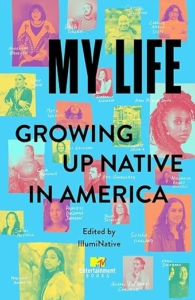My Life: Growing Up Native in America
IllumiNative
MTV Books
Published October 1, 2024
Amazon | Bookshop | Goodreads
About My Life: Growing Up Native in America
A moving collection of twenty powerful essays, poems, and more that capture and celebrate the modern Native American experience, featuring entries by Angeline Boulley, Madison Hammond, Kara Roselle Smith, and many more.
With heart, pathos, humor, and insight, 20 renowned writers, performers, athletes, and activists explore what it means to be Native American today. Through a series of essays and poems, these luminaries give voice to their individual experiences while shedding light on the depth and complexity of modern Native American identity, resiliency, and joy.
The topics are as fascinating and diverse as the creators. From Mato Wayuhi, award-winning composer of Reservation Dogs, honoring a friend who believed in his talent to New York Times bestselling author Angeline Boulley exploring what it means to feel Native enough, these entries are not only an exploration of community, they are also a call for a more just and equitable world, and a road map toward a brighter future.
Edited by IllumiNative, an organization dedicated to amplifying contemporary Native voices, My Life: Growing Up Native in America features contributions from Angeline Boulley, Philip J. Deloria, Eric Gansworth, Kimberly Guerrero, Somah Haaland, Madison Hammond, Nasugraq Rainey Hopson, Trudie Jackson, Princess Daazhraii Johnson, Lady Shug, Ahsaki Baa LaFrance-Chachere, Taietsaró Leclaire, Cece Meadows, Sherri Mitchell, Charlie Amaya Scott, Kara Roselle Smith, Vera Starbard, Dash Turner, Crystal Wahpepah, and Mato Wayuhi.
My Review
This collection features everything from narrative essays recounting deeply formative experiences to poetry to advice for young readers on finding success and happiness. Some explore one’s relationship with oneself. Others unpack their experiences, examining internalized racism and prejudice directed at them.
Each piece differs in style, but the common theme running through them all is a love for Indigenous communities and hope and optimism about the future. The authors come from different tribes and geographical areas, and some share a snippet or two of history. This really highlights the differences in experiences that someone from one tribe may have from another, and yet simultaneously draws attention to the values and beliefs that run true across tribal lines.
I listened to this collection as an audiobook, and I really enjoyed it. I went back and reread some of the entries via the ebook version so that I could sit with the ideas a little more deeply in a few of the entries, especially the poetry.
While the intended audience of this book is young Indigenous readers, I would recommend that anyone read it. How often do we get a chance to listen to so many different Indigenous perspectives in one place? It’s a quick read and definitely worth checking out.
Content Notes
Recommended for Ages 12 up.
Profanity/Crude Language Content
Very few instances of profanity.
Romance/Sexual Content
References to a romantic relationship.
Spiritual Content
References to offerings and traditions, beliefs, and rituals.
Violent Content
References to racism and indian residential schools. One essay explores an instance in which someone was bullied for their appearance. One essay briefly mentions that the author attempted suicide at one point in life.
Drug Content
References to alcohol use.
Note: This post contains affiliate links, which do not cost you anything to use but help support this blog. I borrowed a copy of this book from the public library. All opinions are my own.
